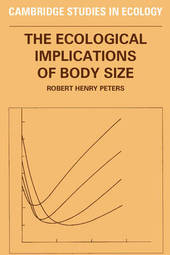
|
The Ecological Implications of Body Size
Paperback / softback
Main Details
| Title |
The Ecological Implications of Body Size
|
| Authors and Contributors |
By (author) Robert Henry Peters
|
| Series | Cambridge Studies in Ecology |
|---|
| Physical Properties |
| Format:Paperback / softback | | Pages:344 | | Dimensions(mm): Height 229,Width 152 |
|
| Category/Genre | Ecological science
Animal physiology |
|---|
| ISBN/Barcode |
9780521288866
|
| Classifications | Dewey:591.4 |
|---|
| Audience | | Professional & Vocational | |
|---|
|
Publishing Details |
| Publisher |
Cambridge University Press
|
| Imprint |
Cambridge University Press
|
| Publication Date |
31 March 1986 |
| Publication Country |
United Kingdom
|
Description
It is generally recognized that larger animals eat more, live longer, have larger offspring, and so on; but it is unusual to see these commonplace observations as a basis for scientific biology. A large number of empirically based relationships describe biological rates as simple functions of body size; and other such relations predict the intrinsic rate of population growth, animal speed, animal density, territory size, prey size, physiology, and morphology. Such equations almost always exist for mammals and birds, often for other vertebrates and invertebrates, sometimes for protozoa, algae, and bacteria, and occasionally even for plants. There are too many organisms to measure all aspects of the biology of every species of population, so scientists must depend on generalizations. Body size relations represent our most extensive and powerful assemblage of generalizations, but they have never been organized for use in ecology. This book represents the largest single compilation of interspecific size relations, and instructs the reader on the use of these relationships; their comparison, combination, and criticism. Both strengths and weaknesses of our current knowledge are discussed in order to indicate the many possible directions for further research. This important volume will therefore provide a point of departure toward a new applied ecology, giving quantitative solutions to real questions. It will interest advanced students of ecology and comparative physiology as well as professional biologists.
Reviews' ... [Peters] has built a brief and engaging quantitative monograph, frank, learned, painstaking and made explicitly helpful to readers with little mathematical experience ... His text is an unequaled review of the field ...' Scientific American ' ... Here is a treasure house of information ... Clearly this is an important book. It is different - and by ignoring cherished disciplines, by blending physiology and ecology, and by looking at problems with a fresh eye, Peters yields new insights and opens up new questions.' Nature 'Peters has produced both a useful introduction to the relationships of body size to several physiological, ecological, and biomechanical processes as well as a source of data on these matters ... Peter's approach is effective, and this small volume could be used in graduate seminars as well as in advanced undergraduate courses in ecology and related subjects.' Choice
|